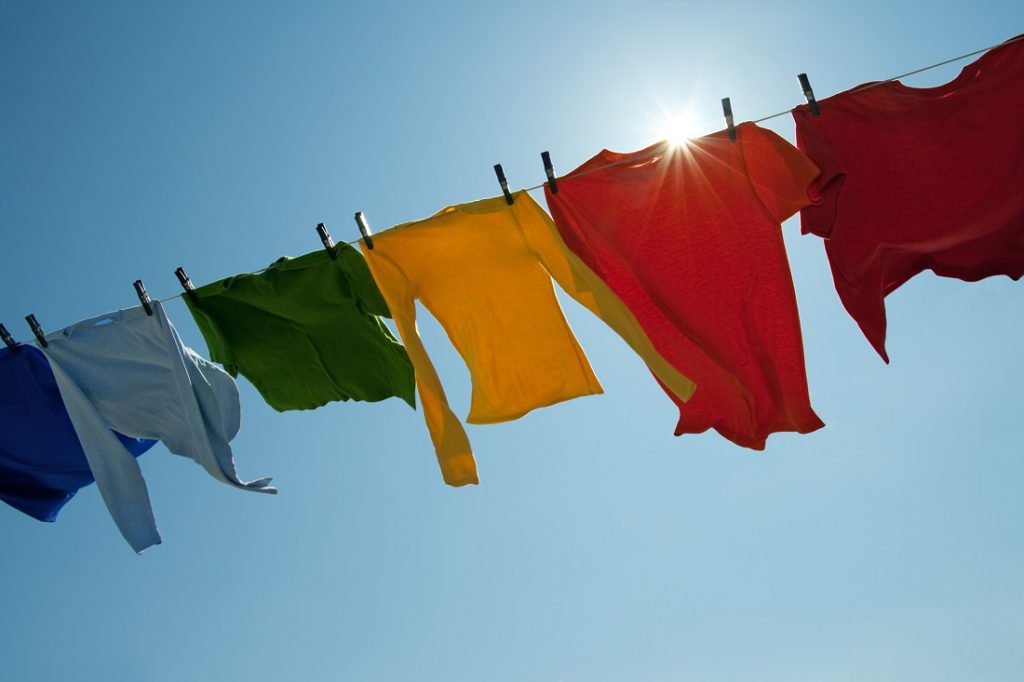Can you sunburn through black clothing? What if it is UPF-treated clothing?
If the UPF treatment has not worn off, you should be protected, at least where the clothing covers you.

While the color black is one of the best colors that blocks the sun the best, the actual fabric of your black clothing is important.
Skin Cancer.org advises that clothing is our first line of defense against the sun. Knowing what to wear can result in better sun protection for your skin than sunscreen can offer.
One of the reasons clothing can protect better than sunscreen is that sunscreen application is kind of iffy. Do you use sunscreen as the directions instruct? Do you use 1 full ounce applied evenly to all exposed skin every day? Then do you reapply every two hours when you’re exposed to the sun?
However, we must remember that not all clothing is created equal.
It is important that you know how different items of clothing work to protect your skin to know how well you’re protected.
Let’s look at how clothing’s color can make a difference.
How Does Black Clothing Block The Sun?
Do black clothes protect you from the sun? Yes, they can. There are several factors in fabric’s ability to protect your skin from the sun.
Here are some rules of thumb to remember so you can make better decisions about protecting your skin from the sun:
In general:
Darker colors provide more protection for your skin than lighter colors do.
Tightly woven fabrics protect your skin better than loosely woven.
Dry fabric usually protects your skin better than wet fabric will.
As for the color black, when the sun’s rays hit your black shirt, the rays are converted into energy. This energy creates some heat. The black shirt will absorb the rays, and the energy will turn into heat.
And yes, this may make you a bit sweatier. This is why the fit is so important. You need room under your shirt for air to dry the sweat.
Even though this heat may get a bit uncomfortable, it is in no way comparable to the heat from sunburn. And you can’t take the pain away by getting in out of the sun as you can with a black shirt to just prevent the burn.
This heat on a hot day is what prompted the manufacturers of UPF clothing to develop a variety of fabrics that breathe in many colors.
However, just because you cover up, all the sun’s UV rays may not be blocked from your skin

Why Will I Sunburn Through Regular Clothes Even If They Are Black?
Who wouldn’t enjoy some time relaxing and being outside on a sunny day, any season?
So first let’s talk about the fact that you can sunburn through clothes.
The reason you sunburn through your clothes is that they are too loosely woven to keep the sun out.
- The fabric is too loosely woven, and the sun can get in between the threads of the fabric. Tightly woven fabric works better at keeping the sun’s rays from going through your clothing.
- Fabric is made of fiber that does not block out the sun.
So now we have UPF clothing. (Ultraviolet Protection Factor)
What Is UPF Clothing?
UPF Is a rating system that lets you know how much sun is being blocked from the skin you have covered in this garment. The weave, fabric content, and colors have all been combined to protect your skin.
There is a science behind the manufacture of this clothing. This UPF rating functions for clothing almost like an SPF rating does for sunscreen.
This protection number gives you an idea of how well a product will protect your skin from dangerous UV rays.
The number indicates what fraction of the sun’s UV rays can penetrate the fabric. So if the tag on the shirt states there is a UPF of 50, that means the shirt would allow just 1/50th of the sun’s UV radiation to reach the skin.
This is 98% protection! You can feel protected with those kinds of numbers. You will get very small amounts of UV through this kind of shirt, but not a dangerous amount. Using safe sun habits of resting in the shade and taking breaks in the state should keep your skin from dangerous UV rays.
Don’t forget you are also being protected from the early aging rays, UVA. Those are the ones responsible for sagging crinkly skin on your arms and wrinkles on your face.
Is Black The Best Color For Sun Protection?
What color is best for sun protection if not black? While darker is declared the best at sun blocking, who wants to wear black all the time?
So let’s review a little color theory as related to your clothing and how well it will block the sun:
What About Other Colors?
The color of your regular clothing that is already in your closet can affect how well it protects you from UV rays. Dark colors like deep red, black, navy blue, green, and brown absorb more of the dangerous rays so they don’t get to your skin.
Remember they will also be warmer to wear, as the UV energy is turned into warm as it passes through your clothing. As warm energy, it will no longer harm your skin.
White and pastels reflect the sun’s rays back and doesn’t absorb them. (Darker color controls the UV rays by making heat. Lighter color controls by reflecting the rays)
So Is Black the best color to stay safe in the sun? Maybe saying Black is a good color is a better statement. So are navy blue, dark red, and deep green.
Again when shopping in your closet for something to wear while out in the sun:
Something is better than nothing. So just because you don’t yet have UPF clothing, don’t go out shirtless! Choose a thicker deeper colored shirt or tee shirt. Covering up is important.
We will discuss fabric and share some guidelines a bit further in this article.
Can you get a sunburn through black pants? You should be safe for a while in black pants if the material is a heavier-weight fabric like denim.
What Is Sun Resistant Fabric?
The fibers that the fabric is woven of are important for this sun-resistant result.
Like color, the fabric content and how tightly it is woven will affect the ability to block the sun.
If the fabric is woven using synthetic or by blending natural and synthetic fibers like polyester or rayon with cotton, you will be protected more.
When using natural fibers like wool or cotton, a heaver weave will be needed to offer the best choices for sun protection. This will make them dense, tightly woven fabrics like wool, denim, or corduroy. Obviously a better choice for fall and winter than summer comfort.
On the opposite end of the spectrum are natural and lightweight fabrics. In this category of fabric, bleached or refined cotton, crepe, and silk will be thinner and let more light pass through.
So as you are shopping in your own closet for sun protecting clothing, you can now make better decisions. You do have garments that will block the sun’s dangerous rays. However, for comfort you may want to add some UPF items to be more comfortable.
What Is The Best Fabric For Blocking UV Rays?
What is the most UV-resistant fabric? We now know that there are several fabrics that will block all but 2% of the sun’s rays. So we do have choices to help us protect our skin.
Is polyester good for sun protection? Yes, polyester is a manmade fabric that will block out the sun and can be thicker or thinner. This makes it an excellent fiber to add to cotton to offer different weights of fabric for pants, and for scarves, and soft shirts.
Is nylon or polyester better for sun protection? Yes, nylon is also a good manmade fabric and blends well with other fibers to produce different textures and weights of fabric.
Bamboo rayon fabric is truly a revelation. In addition to dozens of other powerful natural qualities, the fabric also offers some of the best natural sun protection available.
Bamboo fabric blocks 98 percent of harmful UV light from getting to your skin. This puts this blend of fibers at the top of sun protection for your skin.
SkinCancer.org gives this blend of fibers an excellent rating and recommends the garments.
As bamboo blended fabrics don’t rely on chemicals, you can expect this protection to last through any number of wears and washes. It’s durability and long-scale dependability you can truly count on.
It’s Black Why Worry About UPF 15? UPF 30? UPF 50?
We have already discussed that UPF 50 will allow 2% of the UV rays to get to your skin.
Let’s talk about labels and tags on UPF Clothing. You are going to have to read labels and remember about your UPF clothing. There will be different laundry instructions.
Some can protect a little when wet, some none at all, and others are made for wearing wet. Some are not for chlorine water, some are not for salt water. How do you know the difference? Read the label. You can’t tell these little differences by feeling. Lables are important.
Because of this wide variety now available, I suggest a serious effort to hang on to labels and tags. Zip-lock bags are great for this.
If you are a Mom and you end up with laundry duties, this will save you searching for instructions. I just use masking tape and tape the bag to the inside of the utility room closet door. Where can you tape your handy reference?
How long does the UPF last on my clothes? This link will explain some of the mysteries of UPF protection and how long it lasts.

UPF Clothing Every Day For Antiaging Protection
According to the Skin Cancer Foundation, clothing is the best way to protect your skin from harmful rays.
As long as you have UPF Clothing on your body, it protects you. The clothing doesn’t sweat off, wash off, or require reapplication like sunscreen.
Wearing UPF-rated clothing is also appropriate for those cloudy days when the sun’s rays can still reach your skin. Or in the fall and winter in my part of central Texas.
It may be fall, but the sun is still there, bright and dangerous for someone at a football game in the daytime, or who just enjoys outdoor activities.
Does UPF Clothing Contain Chemicals?
When manufacturing sunblock fabrics for clothing, the two most used ways to make UPF 50+ fabric:
- Dyed fabrics
Material is coated or sealed with colorless dyes that help block out UV rays. This is done during the manufacturing process. Unfortunately, this process is not eco-friendly, and the chemicals typically begin to wash out after a few laundry cycles. This doesn’t assure a very long life span for your UPF garments. - Tightly woven fabrics
The other way to make a fabric UPF 50+ is to make sure the fabric is tightly woven. The tighter the weave, the more UV protection a garment is. When there are no holes between the fibers, UV rays can’t get through.
Manufacturers have other labels for their fabrics that are specially blended to give the same protection and offer more variety for styles and thicknesses of the fabric.
The world of UPF clothing is growing and they are offering many choices for protecting our skin and keeping us comfortable.
Are UV Blocking Shirts Worth The Cost?
Yes, UV-blocking shirts are worth the cost. They will allow you to have fun in the sun and stay protected. Your sunscreen use will go down, although it should not go away.
A long sleeve shirt will protect your skin for many wearings, and if it prevents only one sunburn, is worth every cent you pay.
Obviously, the more skin you cover, the less your risk of sunburn. So long sleeves are important.
Don’t forget your sun hat and sunglasses. These 3 items will go a long way in keeping your skin safe. Sunscreen on your face is the way you should start every day. Applying it to your face is not like having to apply it to your arms, shoulders, or back. You can do this!
Understanding the importance of good protective clothing is important for you to make the move towards safer fun in the sun. This article from the Cleveland Clinic has some good information about clothing and staying safe in the sun to help you practice sun safety for your skin.
Is A Black UPF Shirt Hot To Wear?
Does a black cotton shirt protect you from the sun? Yes, a black cotton shirt can protect you from the sun.
Don’t reach for that old favorite cotton T-shirt if you are shopping in your closet with what you have.
Natural fabrics like cotton for shirts and hemp for sun hats may not do a good job of protecting you from UV rays. Instead, wear clothes made with polyester and nylon, or blends of synthetic with natural fiber.
Are sun protection shirts hot? Yes, they can be!
- Fit: Especially with shirts, it may seem weird, but looser threads will offer better protection than super-tight clothing! Think tee shirt here. If your tee shirt is too tight, the straining can cause fabric fibers to stretch or tear. This in turn will allow more UV rays to pass through the material.
- Check the fit of your sunglasses as well. If your sunglasses slip down your nose, this is leaving your eyes at risk for sun damage. Shop for sturdy sunglasses with oversize lenses that cover the eyes, eyelids, and as much of the surrounding areas as possible.
Trends In UPF Clothing
Athleisure clothing is one of the popular newer trends for UPF clothing.
New blends of fabrics and ongoing technology are allowing a wider scope for comfortable clothing that is UPF rated to keep you safe from the sun.
With this stylish blend of casual aesthetic, performance functions, and the comfort of leisurewear, athleisure just feels incredibly comfortable without sacrificing any essential protection features.
As athleisure is becoming more popular to wear for all sorts of outdoor activities.
Your athleisure styles also offer excellent protection from the sun is an important step. Yes, there are many new things in store for helping us to protect our skin and still be comfortable.
Does Swimming In A Black Rash Guard Prevent Sunburn?
Rash Guards? Swim Shirts? Sun Shirts?
Does swimming in a shirt prevent sunburn? If the shirt is specially designed to retain its UPF rating when wet, yes, it will.
There seem to be some questions about what to swim in for sun protection.
Your old favorite t-shirts offer very little UV protection. So any built-in UPF will provide more protection against sunburn than a regular t-shirt or even a regular long-sleeve shirt.
Remember as well, sunscreen should still be worn on your face and chest, or other areas not protected by your clothing.
There is a great article by Title Nine that explains the difference between rash guards, swim shirts, and sun blocking shirts. This can help you understand what to expect from each kind and make it easier to understand how to make them work for you.

Sami’s Take On Can You Sunburn Through Black Clothing
This question of Black Being Best may not be true. There are choices when we are selecting our sun-safe clothing.
The world of UPF clothing is important for our skin health. Learning how to protect yourself and your family will help prevent skin cancer for your loved ones.
Color will be less important as you are selecting your UPF garments. More important will be the UPF numbers. However, remembering the darker will be better is important for purchases that are not UPF-rated.
I hope that the information gathered here will help you walk through the skin protection from sun problems for yourself and your family. Skin cancer is a real danger.
Adding information to what you already have for making decisions about what is good to wear in the sun. If your area is sunny as many hours a day as it is where we live, we have lots of time to accidentally get too much sun!
Becoming aware of how you can protect your skin with clothing will make changing some old careless habits easier. Remember your sun hat, sunglasses, and a loose-fitting long-sleeve shirt with a collar will protect you well. Add sunscreen where you are not protected, your face, and your hands.
Also, remember to look for some shade to break up a long day outdoors.
Awareness goes a long way in protecting your skin, and preventing early aging and skin cancer.
Thank you,
Sami